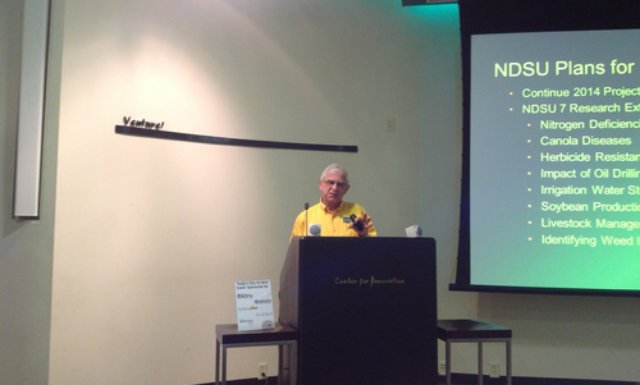A great deal of work and research remains before agriculture takes full advantage of unmanned aerial vehicles, but tremendous opportunities justify the effort, UAV and ag officials say.
“The future is still evolving. Farmers are business people. They can’t afford to be making wrong decisions,” said John Nowatzki, agricultural machine systems specialist with the North Dakota State University Extension Service.
But farmers, ranchers and others involved in agribusiness realize that UAVs have great potential, in everything from dealing with herbicide-resistant weeds to keeping tabs on the health of cattle in pastures, he said.
Nowatzki was one of the speakers at a conference on the use of UAVs in agriculture. The event was sponsored by the agribusiness committee of the Chamber of Commerce of Grand Forks (N.D.) and East Grand Forks (Minn.) The sister cities are separated by the Red River; the Red River Valley provides some of the world’s best cropland on which a wide range of crops, including corn, soybeans, wheat, edible beans, potatoes and sugar beets, are grown.
Luke Geiver, managing editor of Grand Forks-based UAS Magazine, which covers the UAV industry, and Lionel Olson, a former Grand Forks County (N.D.) extension agent who’s now a sales agronomist for Integrated Ag Services, also spoke at the conference.
Big deal in ag
Unmanned aerial vehicles, also known as drones and unmanned aircraft systems, or UAS, are one of the hottest topics in agriculture.
Geiver said his magazine covers UAV events and activities across the country. But he said it’s fortunate to be based in Grand Forks, home to the University of North Dakota.
UND is a national leader in UAV research and education, and several other area higher education institutions are involved as well.
“North Dakota has some of the biggest things happening” in the UAV industry, he said, noting that one member of his magazine’s staff says, “The world envies us.”
“Everyone in this room will be impacted by UAV activity,” Geiver said to a group that included farmers, ag bankers and others involved in agriculture.
Nowatzki said that dealing with herbicide-resistant weeds, a mounting concern in the Upper Midwest, will be one of the first areas in which farmers pay to use UAVs.
Over time, individual farmers increasingly will use UAVs for crop scouting, yield prediction and in-season fertilization, while crop and livestock consultants will use them to increase business efficiency, he predicted.
Even so, progress needs to be made in many area, including sensors, cameras, data transfer, management and analysis, and the battery capacity of small UAVs, he said.
Analyzing data to make it financially useful will be particularly important, he said.
Ag producers “won’t pay for imagery. They’ll pay for analysis,” he said.
Olson talked about some of his own experiences and challenges in using UAVs, including the time the small UAV he was operating nosedived and crashed, busting the camera attached to it.
For now, at least, “A guy can go up and make a lot of pretty images (using a UAV). But you still need the interpretive part,” he said.
“We’re still figuring out how to make this work in a (farming) operation,” he said. “The research needs to catch up with the technology … But it will come.”
Source: AG Week

